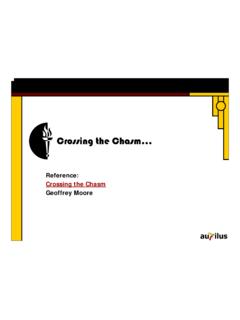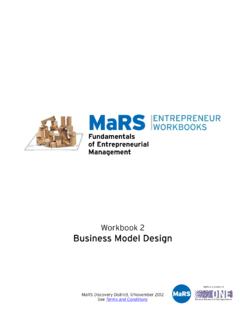Transcription of Revenue Management - HOSPA
1 Revenue ManagementHOSPA - PRACTITIONER SERIES An introduction for practitioners Acknowledgements i 2013 Hospitality Professional Association This work is protected by copyright. All rights reserved. No part of this publication may be reproduced, stored in a retrieval system, or transmitted in any form or by any means, electronic, mechanical, photocopying, recording or otherwise, without prior written permission of the copyright 978-0-9572005-3-1 Published by Wentworth Jones Limited Midland HousePoole RoadBournemouth BH2 5 QThis eBook has been prepared and produced by the Hospitality Professionals Association ( HOSPA ) with the financial support of the Savoy Educational Trust. Additional support has been provided by Oxford Brookes University and the Higher Education Funding Council for Adams Cathy Burgess Judith KellyKate RinghamKate VariniEditor: Peter A Jones Editorial Assistant: Lucy VierbergenAimsiiAims of the BookThis book provides an introduction to the world of Revenue Management and how it can be used in the hospitality industry.
2 Objectives of the BookThe principle aim of this eBook is to enable the reader to develop their knowledge of Revenue Management practices including how the core components of Revenue Management and how these are applied within the service the motivation of the customer in making purchase the influence of the economic cycle in consumers purchase the nature of competitive the principles of market segmentation for a the core components of pricing and its impact (in a variety of demand periods) on value the key skills required for a Revenue you progress through this book you have the opportunity to test your knowledge and understanding using the interactive review is Revenue Management ?A commonly accepted definition of Revenue Management is to sell:The Right ProductTo the Right CustomerAt the Right TimeFor the Right PriceThrough the Right Channel WHAT IS Revenue Management ?
3 Revenue Management (RM) is the art and science of maximising Revenue under variable conditions. It is a Management tool that has the objective of increasing sales revenues by manipulating the prices at which fixed products ( hotel rooms and airline seats) are made available for sale in relation to the current and forecasted are now very aware that the price they would need to pay for an airline seat or a hotel room will vary significantly depending upon the point at which they make a purchase decision and the availability of the seat or room. This change in the way that customers perceive the pricing of these products has been relatively recent but universally Revenue Management has developed, it has become more disciplined and technical in using a variety of analytics to predict consumer demand, and to optimise the inventory and price availability to maximise Revenue . The essence of this discipline is in understanding the customers' perception of product value and accurately aligning product prices, placement and availability with each customer 1 Section Objective: Understand the core components of Revenue Management and how these are applied within the service Management4 HISTORY The deregulation of the airline industry is generally seen as the catalyst for Revenue Management (and its precursor, yield Management ).
4 The terms Revenue Management and yield Management are often confused, yet there is a key distinction between the two disciplines. Whereas Revenue Management involves predicting consumer behaviour by; segmenting markets, forecasting demand and optimising prices for several different types of products, yield Management refers specifically to maximising Revenue through inventory control. Thus, yield Management is a tactical application within the broader field of Revenue Management .After the US Government deregulated the airline industry in the early 1980s, Revenue Management practices were first launched. Over the next few years, yield tactics became common practice among major airlines. However, Revenue Management may reasonably be assigned an inception date of 17th January 1985 when American Airlines launched its Ultimate Super Saver fares to compete with the low cost carrier Management was born out of the need to fill at least a minimum number of seats to cover fixed operating expenses.
5 Once these fixed costs were covered, the remaining capacity could then be sold at higher rates to maximise Revenue and profit. The hotel industry recognised the benefits of adopting a Revenue Management approach as practiced by the airline sector but initially growth of the technique was held back by the lack of appropriate technology available to manage data and the shortage of meaningful information about guests. The final challenge to overcome was how to manage the length of stay a feature which is different to that experienced by the COMPONENTS Most businesses will face complex decisions regarding their pricing and selling strategy. Namely, what product to sell, who is the target customer, when is the ideal time to sell, how much to sell that product for, and what is the best route to market (considering such factors as cost of sale and brand image). An overview of the key variables in Revenue Management is shown in Fig 1.
6 It is the complex interrelationship between the variables that needs to be understood to be able to make Management decisions on pricing and yield to generate Revenue . As the model illustrates the complexity is bounded by the constantly changing pressures on the different variables, the market is influenced by economic conditions, pricing similarly, the segments of the market change by the nature of the purchase decision and customers changing expectations. At the heart of the Revenue Management strategy is the customer, as understanding customer behaviour and attitudes towards price 5and purchasing is a core determinant in the success of any company s Revenue Management strategy. With the overall aim of maximising Revenue , being able to manage variables in this complex equation relies on an understanding of the dynamics of those variables and how they change over time. Reliance on automated complex algorithms is not the entire answer as it s the underlying concepts that need to be properly understood to have confidence that any algorithm will produce an appropriate result.
7 The ability to scan the wider economic environment and understand trends is an important consideration when forecasting Management is of particular value in situations where the proportion of fixed costs is high compared to the proportion of variable costs. The less variable cost there is the more added Revenue will contribute to overall profit. For example when a hotel room is sold for 300 per night only a small proportion of this selling price is spent on variable costs such as guest amenities, cleaning, laundry and energy consumed. Variable costs may only amount to around 10 - 20% of the selling price. The remainder is the contribution to fixed costs and then a result the concept of Revenue Management can be applied to the selling of hotel bedrooms and to other areas in the hospitality industry such as conference and banqueting, and food and beverage where the Management of fixed resources is essential to maximise Management relies on the collection of data and factual evidence to support strategies and their tactical application, to increase both Revenue and profit.
8 Revenue Management uses the basic principles of supply and demand economics, in a tactical way, to generate incremental Management in the service sector is distinct and more complex in comparison to other sectors. For an overview of the current use of RM in the hospitality sector read this opinion piece by Dr. Gabor Revenue Growth Revenue Management Constraints Hard Supply Soft SupplyCost Base Conditions Perishability High Fixed Costs Low Variable Costs The Market Economic Conditions Segmentation Pricing Forecasting Demand Yield Figure 1 Components Revenue ManagementCONDITIONS AND CONSTRAINTS To be of practical use, Revenue Management can only exist where certain sets of conditions and constraints apply. These conditions and characteristics, whilst not individually unique to the service sector, when taken together, provide a complex set of interrelationships that need to be analysed and understood.
9 There are a number of essential conditions for Revenue Management to be applicable. These are shown in Interactive Diagram 1. Condition 1 and 2 taken together characterise the supply constraints. There is a limited supply only available at that moment in time. This is referred to as hard supply . The hotel has a fixed number of rooms, the airline has a fixed number of seats, and the cruise liner has a fixed number of cabins. Soft supply however is a constraint where it may be possible to increase supply to meet demand but that supply may not be at the times or indeed places where the demand is greatest. For example a restaurant could increase its opening times to increase the availability of seats and supply but that in turn may not increase the Revenue unless customers come during those times and spend only is the supply fixed it is also perishable. An airline seat, cabin on a cruise liner, a room or a meal, cannot be stored in inventory and reused on another occasion.
10 If not sold for the specific flight, cruise or day, the opportunity for the sale is customer must be prepared to pay variable prices dependent upon the nature of the product and the demand. The fact they re prepared to pay a variable price for the same product as with airline seats and hotel rooms creates the unique environment in which Revenue Management can work. Condition 1 Condition 2 Condition 3 Condition 4 Condition 5 Interactive 1 Essential Conditions for Revenue Management Explore the 123457 Low variable costs, this refers to the relatively low costs in servicing either the airline seat or the hotel fixed costs,; this refers to the conditions where there are high fixed costs in providing the product or service that need to be recovered. The costs of operating the airplane, the cruise liner or the hotel are largely fixed irrespective of the number of passengers or guests using supply; this is a constraint where the operator cannot increase or decrease the number of seats or rooms they offer in relation to the supply; is a key feature of Revenue Management and is defined as: When sellers cannot readily increase the amount of products or services available for sale when consumer demand for them increases.






